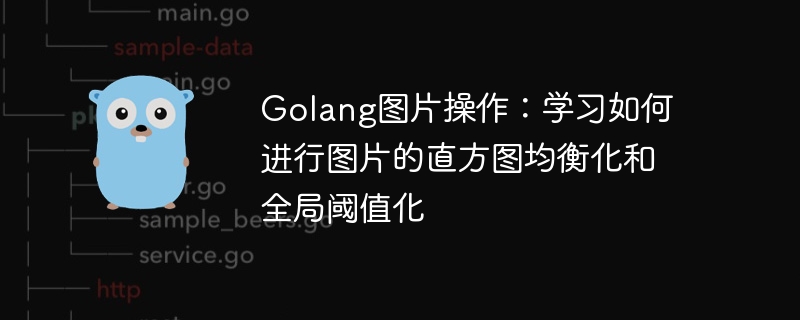Golang图片操作:学习如何进行图片的直方图均衡化和全局阈值化
- 王林原创
- 2023-08-18 14:49:52831浏览

Golang图片操作:学习如何进行图片的直方图均衡化和全局阈值化
引言:
图片处理是计算机视觉和图像处理领域中的重要任务之一。在实际应用中,我们常常需要进行一些图像增强操作,以提高图像的质量或者突出图像中的某些特征。本文将介绍如何使用Golang进行图像的直方图均衡化和全局阈值化操作,以实现图像增强的目的。
一、直方图均衡化
直方图均衡化是一种常用的图像增强方法,它通过对图像像素的灰度分布进行调整,使得图像的对比度得到增强。在这种方法中,我们首先计算图像的累积直方图,然后根据累积直方图对图像进行像素值的调整。
下面是一个简单的Golang代码示例,用于实现图像的直方图均衡化:
package main
import (
"fmt"
"image"
"image/color"
"image/jpeg"
"os"
)
func main() {
// 打开图片文件
file, err := os.Open("input.jpg")
if err != nil {
fmt.Println(err)
return
}
defer file.Close()
// 解码图片
img, _, err := image.Decode(file)
if err != nil {
fmt.Println(err)
return
}
// 计算直方图
hist := histogram(img)
// 计算累积直方图
cumHist := cumulativeHistogram(hist)
// 根据累积直方图对图像进行像素值调整
newImg := adjustPixels(img, cumHist)
// 保存处理后的图像
outFile, err := os.Create("output.jpg")
if err != nil {
fmt.Println(err)
return
}
defer outFile.Close()
// 编码图像
err = jpeg.Encode(outFile, newImg, &jpeg.Options{Quality: 100})
if err != nil {
fmt.Println(err)
return
}
fmt.Println("图像处理完成!")
}
// 计算直方图
func histogram(img image.Image) []int {
bounds := img.Bounds()
w, h := bounds.Max.X, bounds.Max.Y
hist := make([]int, 256)
for y := 0; y < h; y++ {
for x := 0; x < w; x++ {
r, _, _, _ := img.At(x, y).RGBA()
gray := color.Gray{uint8(r / 256)}
hist[gray.Y]++
}
}
return hist
}
// 计算累积直方图
func cumulativeHistogram(hist []int) []int {
cumHist := make([]int, len(hist))
cumHist[0] = hist[0]
for i := 1; i < len(hist); i++ {
cumHist[i] = cumHist[i-1] + hist[i]
}
return cumHist
}
// 根据累积直方图调整像素值
func adjustPixels(img image.Image, cumHist []int) image.Image {
bounds := img.Bounds()
w, h := bounds.Max.X, bounds.Max.Y
newImg := image.NewRGBA(bounds)
for y := 0; y < h; y++ {
for x := 0; x < w; x++ {
r, g, b, a := img.At(x, y).RGBA()
gray := color.Gray{uint8(r / 256)}
val := uint8(float64(cumHist[gray.Y]) / float64(w*h) * 255)
newImg.Set(x, y, color.RGBA{val, val, val, uint8(a / 256)})
}
}
return newImg
}在上述代码中,我们首先通过image包的Decode函数将输入图像文件解码为image.Image类型的对象。然后,我们分别调用histogram函数计算图像的直方图,cumulativeHistogram函数计算图像的累积直方图。最后,我们根据累积直方图调整图像的像素值,并使用jpeg包的Encode函数将处理后的图像保存到文件中。image包的Decode函数将输入图像文件解码为image.Image类型的对象。然后,我们分别调用histogram函数计算图像的直方图,cumulativeHistogram函数计算图像的累积直方图。最后,我们根据累积直方图调整图像的像素值,并使用jpeg包的Encode函数将处理后的图像保存到文件中。
二、全局阈值化
全局阈值化是一种简单但有效的图像二值化方法,它将图像的像素值分为两个互不重叠的光滑区域,分别代表目标物体和背景。这种方法通常应用于具有明显的前景和背景差异的图像。
下面是一个简单的Golang代码示例,用于实现图像的全局阈值化:
package main
import (
"fmt"
"image"
"image/color"
"image/jpeg"
"os"
)
func main() {
// 打开图片文件
file, err := os.Open("input.jpg")
if err != nil {
fmt.Println(err)
return
}
defer file.Close()
// 解码图片
img, _, err := image.Decode(file)
if err != nil {
fmt.Println(err)
return
}
// 根据全局阈值对图像进行二值化处理
newImg := binarize(img)
// 保存处理后的图像
outFile, err := os.Create("output.jpg")
if err != nil {
fmt.Println(err)
return
}
defer outFile.Close()
// 编码图像
err = jpeg.Encode(outFile, newImg, &jpeg.Options{Quality: 100})
if err != nil {
fmt.Println(err)
return
}
fmt.Println("图像处理完成!")
}
// 根据全局阈值对图像进行二值化处理
func binarize(img image.Image) image.Image {
bounds := img.Bounds()
w, h := bounds.Max.X, bounds.Max.Y
newImg := image.NewRGBA(bounds)
threshold := calculateThreshold(img)
for y := 0; y < h; y++ {
for x := 0; x < w; x++ {
r, g, b, a := img.At(x, y).RGBA()
gray := color.Gray{uint8(r / 256)}
var val uint8
if gray.Y > threshold {
val = 255
} else {
val = 0
}
newImg.Set(x, y, color.RGBA{val, val, val, uint8(a / 256)})
}
}
return newImg
}
// 根据图像的直方图计算全局阈值
func calculateThreshold(img image.Image) uint8 {
hist := histogram(img)
totalPixels := img.Bounds().Max.X * img.Bounds().Max.Y
// 计算背景像素值的总和
var bgSum, bgCount, fgSum, fgCount int
for i := 0; i < len(hist); i++ {
if i <= 128 {
bgSum += i * hist[i]
bgCount += hist[i]
} else {
fgSum += i * hist[i]
fgCount += hist[i]
}
}
// 计算背景和前景的平均灰度值
bgMean := bgSum / bgCount
fgMean := fgSum / fgCount
// 根据背景和前景的平均灰度值计算阈值
return uint8((bgMean + fgMean) / 2)
}
// 计算直方图
func histogram(img image.Image) []int {
bounds := img.Bounds()
w, h := bounds.Max.X, bounds.Max.Y
hist := make([]int, 256)
for y := 0; y < h; y++ {
for x := 0; x < w; x++ {
r, _, _, _ := img.At(x, y).RGBA()
gray := color.Gray{uint8(r / 256)}
hist[gray.Y]++
}
}
return hist
}在上述代码中,我们首先通过image包的Decode函数将输入图像文件解码为image.Image类型的对象。然后,我们调用calculateThreshold函数计算图像的全局阈值。最后,我们根据全局阈值将图像进行二值化处理,并使用jpeg包的Encode
全局阈值化是一种简单但有效的图像二值化方法,它将图像的像素值分为两个互不重叠的光滑区域,分别代表目标物体和背景。这种方法通常应用于具有明显的前景和背景差异的图像。
image包的Decode函数将输入图像文件解码为image.Image类型的对象。然后,我们调用calculateThreshold函数计算图像的全局阈值。最后,我们根据全局阈值将图像进行二值化处理,并使用jpeg包的Encode函数将处理后的图像保存到文件中。🎜🎜总结:🎜本文我们介绍了如何使用Golang进行图像的直方图均衡化和全局阈值化操作。直方图均衡化可用于提高图像的对比度,使图像更加清晰和鲜明;全局阈值化可用于将图像转换为二值图像,突出图像中的目标物体。通过灵活运用这两种方法,我们可以实现对图像的增强和特征提取,满足各种应用需求。在实际应用中,我们可以结合其他图像处理算法,进一步提升图像处理的效果和质量。🎜以上是Golang图片操作:学习如何进行图片的直方图均衡化和全局阈值化的详细内容。更多信息请关注PHP中文网其他相关文章!

